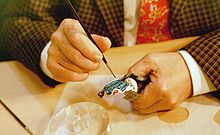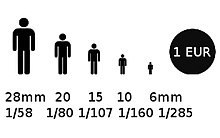Tabletop
As a tabletop ( Engl. "Tabletop") refers to a strategy game system , (cast earlier of a tin alloy or cut out of paper, now mostly in the with miniature figures tin or plastic figures ) is played on a surface (especially tables). The play area is often designed with so-called “ terrain pieces ” (hills, forests, ruins from toy shops or self-made). Since there is no conventional game board, distances (movement or shooting ranges) are measured with a tape measure in most control systems. Some systems use hex fields to represent distances. The figures are usually carefully assembled from prefabricated kits and lavishly painted or purchased in the form of collectible figures. The tabletop can be classified in the field of conflict simulation games.
With the page TableTopTurniere.de a platform was created in the German-speaking area in which players can organize and offer tournaments. The website also has ranking lists. Meanwhile, the website is also known outside the German-speaking area, especially in France.
history
Today's tabletop games are further developments of the so-called " war game ", which was designed by Baron von Reisswitz at the beginning of the 19th century to train Prussian officers in questions of strategy.
Genres
Although it is not uncommon to use a tabletop set of rules to represent different backgrounds, most tabletop systems can be assigned to a genre. The tabletop games currently most widespread in Germany have a fantasy - or science fiction - or historical background ( historical tabletops ).
Genres such as horror, adventure (pirates, etc.), western or pulp (pseudo-historical in comic or Hollywood style) are less widespread so far, but the number of publications has increased significantly in recent years.
Fantasy and science fiction tabletops
Fantasy and science fiction tabletops use backgrounds specially developed for the game as well as well-known fantasy worlds, such as B. JRR Tolkien's Lord of the Rings or the Star Wars universe, used to increase the recognition value and minimize the entry barriers. The most common elements in these fantasy tabletops are magic, fictional races such as B. Orcs or futuristic objects like laser weapons and spaceships.
Historical tabletops


The historical tabletops show troops or armies that actually existed in history. Historical control systems can be roughly divided into three epochs: Antiquity and the Middle Ages, modern times up to 1900 and modern times from 1900. The further classification is based on historical epochs and regions. (For example early Middle Ages , Renaissance , Seven Years War , Napoleonic Wars , scenarios for World War II , American War of Independence, etc.). The division mostly follows technical constraints. While it is relatively easy to depict antiquity, the Middle Ages and even fantasy backgrounds with a single set of rules, e.g. For example, the requirements for rules for the Thirty Years War and the War of the Spanish Succession are so strong that different rule systems are usually used here. A special feature of historical tabletops is the neglect of conflicts, which arouse less interest in the Anglo-Saxon region, since most systems come from Great Britain or the USA. There are dozens of detailed rules and series of figures on the British Isles for the Middle Ages, but very little about the German or Italian Middle Ages.
Differentiation from board and role-playing games
The boundaries between tabletop and other games are often fluid. Some board games with miniatures such as B. HeroQuest are designed for tabletop beginners, variants with a variable game plan can almost be described as tabletop. On the other hand, classic tabletops such as Battletech or Demonworld can almost be described as board games thanks to their ready-made game plans. The transition to role play is similarly fluid . While role-players do use miniatures to represent their actions in the game, there are also tabletops whose rules have a strong role-play component.
Rules of the game
With sometimes very complex rules of the game, attempts are made to implement as many aspects of an actual battle as possible in the game. In many tabletops, the morale of the troops, advantages and disadvantages of terrain and equipment as well as units with special skills and tactics such as phalanx , skirmishers , cavalry and, of course, the properties of the various weapons are implemented. A compromise always has to be found between complicated, realistic rules and simple, abstract rules. This is also the fundamental difference between the various control systems.
According to the rules, most actions are determined by rolling dice . In addition to the usual six-sided dice, many systems also use special dice with other side numbers. Some less common systems are played with the help of playing cards or use combinations of dice and cards. In addition, there are systems that largely eliminate chance and work primarily by comparing property values.
Standards
The figures from tabletops are available in different sizes and scales. Figures of the sizes 6 mm, 10 mm, 15 mm, 25 mm, 28 mm, 32 mm and 54 mm, as well as the scales 1:87, 1:76, 1:72 and 1:64 are most frequently used. The mm number indicates the size of an average human model in millimeters. In the case of classic figures, however, this can also mean the height of the miniature from the floor to the eyes, since most historical miniatures wear headgear, which could lead to an inaccurate size specification. The 6 mm, 10 mm and 15 mm scales are mostly used for historical tabletops, while the 25 mm and 28 mm scales are mainly used for fantasy and science fiction tabletops because it enables a higher level of detail in the figures.
The scale decides whether the tabletop game is more intended to represent large troop units with large regiments, or whether more emphasis is placed on individual miniatures, which are correspondingly less numerous, but modeled in more detail and equipped with more precise special rules.
In addition to the scale, the addition "Heroic" - (scale) or "True" - (scale) is often mentioned. "True" refers to models with realistic proportions, while "Heroic" -scale models show heads, hands and weapons (sometimes also arms, legs and feet) in relation to the torso of the miniature.
Collectible miniature games
Mage Knight incorporated the collector effect known from Trading Card Games through “booster packs”, in that the figures (already pre-painted here) were sold in packaging units, where it was not clear which figure was purchased. In addition, the stand area (technical term: base ) is used as a life point and value display. This type of base use is very common in this sector, also with Dreamblade (see below) and HeroClix . There is also a collectors' market that focuses on old, no longer produced miniatures.
The US company Wizards of the Coast (WotC), which grew up through Trading Card Games, launched the collectible miniature game Dreamblade in August 2006 on a similar basis (booster) . Dreamblade only stayed there for barely two years. WtoC subsequently marketed a Star Wars miniature series, which enabled both figure battles and later space battles.
The proximity to board games is greatest with the games mentioned above. All are played on prefabricated playing fields that have a grid. However, these are either highly flexible (Mage Knight, Star Wars) or highly abstract (Dreamblade, HeroClix).
A collectible miniature game that works without the booster pack effect is the Star Wars X-Wing Miniatures Game ( Fantasy Flight Games , in Germany by Heidelberger Spieleverlag , 2012), whose pre-painted miniatures can be purchased specifically. The rules are reminiscent of a board game, but the game works without a game board.
Tabletop systems and companies offering them
Warhammer is one of the traditional systems and represents battles between fantasy armies. Troops are combined in combat units or regiments and controlled in groups. The number of models per army is usually over 100 models. Skirmish tabletops, on the other hand, require far fewer models. Most of the time, each model is played separately (e.g. Fearless) or grouped into 2–4 models in smaller units (e.g. Dark Age, Arcane Codex Arena and Warmachine / Hordes or the Lord of the Rings Skirmish Tabletop). Chronopia , Warzone or Titan2577 represent intermediate areas , which can be used by considerably larger troop units, but use a large number of individual models. Games Workshop products such as Warhammer Fantasy , Warhammer 40,000 and Lord of the Rings are widespread .
Besides Games Workshop there are other well-known companies: Excalibur miniatures with Fearless , Titan2577 and Magic Challenge ; Rackham with Confrontation and AT-43 ; Urban Mammoth with Urban War and Metropolis ; Wizkids with Mage Knight, Mechwarrior: Dark Age and Crimson Skies; FANPRO LCC with Classic BattleTech (the better-known Mechwarrior predecessor), Kraken Editions with Alkemy , Cipher Studios with Helldorado , Corvus Belli with Infinity the Game , Privateer Press with Warmachine and Hordes and Ral Partha Europe with Demonworld .
In the field of historical battles, De Bellis Magistrorum Militum (DBMM for short), De Bellis Multitudinis (DBM) together with its smaller brother De Bellis Antiquitatis (DBA) is very common. In Germany, DBM is mainly played on a 15 mm scale. Both systems cover the period from around 3000 BC to the late 16th century. Games Workshop is with Warhammer Ancient Battles , Legends of the Old West u. a. represented. Other major systems released in recent years include Field of Glory and Force on Force from Osprey Publishing , a specialist military history publisher, and Flames of War from Battlefront .
There are also many companies that have a large number of figures in their range that are not produced for a specific game system, for example Ral Partha, Gamezone, Fenryll, Foundry, Reaper Miniatures, Thomarillion, Freebooter Miniatures, TIN Bitz and Assassin Miniatures .
In 2004 toy giant Hasbro launched an entry-level tabletop called Heroscape , which compared to its big brothers has a rather simple control system. The main difference is that Heroscape has a changeable 3D landscape on which the battles take place.
Web links
- Tabletop wiki with many game descriptions
- Overview of tabletop tournaments
- The International Website for the tabletop hobby (Engl.)
- Website with news about the hobby tabletop (engl.)
Individual evidence
- ↑ T³ c / o Althaus.IT: T³ - TableTop Tournaments - Germany. Retrieved November 4, 2019 .





